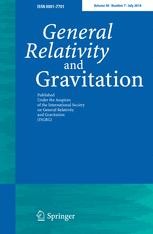GRG Editor's Choice: Difficulties of quantitative tests of the Kerr-hypothesis with X-ray observations of mass accreting black holes
 Krawczynski, H., Difficulties of quantitative tests of the Kerr-hypothesis with X-ray observations of mass accreting black holes, Gen Relativ Gravit (2018) 50: 100. https://doi.org/10.1007/s10714-018-2419-8
Krawczynski, H., Difficulties of quantitative tests of the Kerr-hypothesis with X-ray observations of mass accreting black holes, Gen Relativ Gravit (2018) 50: 100. https://doi.org/10.1007/s10714-018-2419-8
Editor's Choice (Invited Review: State of the Field)
First Online: 24 July 2018
Part of the Topical Collection: "Testing the Kerr spacetime with gravitational-wave and electromagnetic observations"
"This article is a valuable contribution to the literature concerning how to use electromagnetic observations of BHs to test general relativity. Many articles in the literature present calculations surrounding such observations and tests of GR, but very few of them take a critical eye towards the difficulties involved—most importantly, degeneracies in observations. Besides giving a good overview of the state of the field, this manuscript's main point is that these degeneracies complicate the program of testing GR with X-ray observations of BHs, and one way to control these degeneracies is a better choice of parameterization."
Abstract:
X-ray studies of stellar mass black holes in X-ray binaries and mass-accreting supermassive black holes in Active Galactic Nuclei have achieved a high degree of maturity and have delivered detailed information about the astrophysical sources and the physics of black hole accretion. In this article, I review recent progress made towards using the X-ray observations for testing the “Kerr hypothesis” that the background spacetimes of all astrophysical quasi-stationary black holes are described by the Kerr metric. Although the observations have indeed revealed clear evidence for relativistic effects in strong-field gravity, quantitative tests of the Kerr hypothesis still struggle with theoretical and practical difficulties. In this article, I describe several recently introduced test metrics and review the status of constraining the background spacetimes of mass accreting stellar mass and supermassive black holes with these test metrics. The main conclusion of the discussion is that astrophysical uncertainties are large compared to the rather small observational differences between the Kerr and non-Kerr metrics precluding quantitative constraints on deviations from the Kerr metric at this point in time. I conclude with discussing future progress enabled by more detailed numerical simulations and by future X-ray spectroscopy, timing, polarimetry, and interferometry missions.
The author:
Henric Krawczynski is is Professor in the Department of Physics at Washington University in St. Louis, where he works on experimental and theoretical astroparticle physics. He is is the Principal Investigator of the balloon-borne X-Calibur polarimetry mission. X-Calibur studies the polarization of hard X-rays from mass accreting black holes and rotation and accretion powered neutron stars. On the theoretical side, Krawczynski has studied general properties of radiation processes, the observational appearance of black holes (based on General Relativistic ray tracing studies), and on models describing the continuum emission from the ultrafast outflows of mass accreting black holes. The experimental and theoretical work aims at using astrophysical observations to test the Standard Model of Particle Physics and to probe General Relativity in the strong gravity regime.
GRG Editor's Choice:
In each volume of GRG, a few papers are marked as “Editor’s Choice”. The primary criteria is original, high quality research that is of wide interest within the community.
